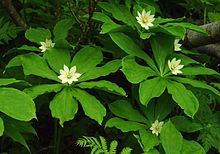
Top Ten Genomes - (iii) Paris japonica
Does freshwater protist Polychaos dubium have the largest genome? At 670 billion nt (200x human genome), it does sound like really large, but Casey L. McGrath and Laura Katz warned - “The genome size of A. dubia has yet to be estimated using current molecular techniques, so this estimate should be viewed with caution.”
Excluding Polychaos dubium, the honor for the largest genome goes to animal marbled lungfish (133 billion nt) and plant Paris japonica (150 billion nt).

-———————————————————————–

But apart from ‘pissing contest’ between organisms, what does genome size really tell us about biology? Very little, as it turns out. Canadian evolutionary biologist T. Ryan Gregory, who spent many years studying the sizes of genomes, wrote a review paper titled ‘A guided tour of large genome size in animals: what we know and where we are heading’ with the following highlights -
1. Based on data collected on ~5000 animal genomes so far, genome sizes were found to vary 7000-fold. That is an enormous range.
2. Animals with the largest genomes lungfish (~80-120Gbp), salamanders (similar order), sharks (~10-20Gbp), grasshoppers, flatworms and crustaceans.
3. The only phenotypic links with genome size are in larger cell size and longer time to do cell division for organisms with large genomes.
4. Ecological correlation An emerging trend from animal (and more specifically, crustacean) genome size studies is the positive relationship between genome size and latitude.
5. Correlation with intron size Intron size and genome size are known to be positively correlated between species of Drosophila (Moriyama et al. 1998), within the class of mammals (Ogata et al. 1996), and across eukaryotes in general (Vinogradov 1999).
6. No relationship between genome size and animal complexity has ever been found. Researchers have been looking into this for over four decades.
The last point is so important that we decided to nominate Paris japonica among the top ten genomes. Ecological correlation is quite fascinating too. What are the evolutionary implications?
Needless to add that large genomes pose quite a bit of challenge to the bioinformaticians trying to assemble them. Legendary bioinformatician Eugene Myers is using Pacbio technology to solve one such 32 Gbp puzzle.